An interview of Bishop Athanasius Schneider about the SSPX, women and footwashing, the consecration of Russia, anti-pastoral bishops, and more
We do not endorse unreservedly every statement of Bishop Athanasius Schneider, auxiliary bishop of the Archdiocese of Mary Most Holy in Astana, Kazakhstan. However, Schneider’s voice has become an influential one in the Church, especially in more “traditional” circles, and we felt our readers should be aware of that voice. Schneider was born in Tokmok, Kyrgyzstan, into an ethnically German family, on April 7, 1961 and so is 54 years old. He is a member of the Canons Regular of the Holy Cross of Coimbra. He was ordained a priest on March 25, 1990 and consecrated a bishop on June 2, 2006. He has written a book entitled Dominus Est — It Is the Lord: Reflections of a Bishop of Central Asia on Holy Communion. He criticizes Church leaders who seek to change the doctrine of the Church: “Those clerics want another Church and even another religion: a naturalistic religion which is adapted to the spirit of the time. Such clerics are really wolves in sheep’s clothing, often flirting with the world, not courageous shepherds but rather cowardly rabbits.”
For Schneider, we live “in a time in which a great part of the holders of the office of the Magisterium are negligent in their sacred duty.” He respectfully but clearly does not exclude the Pope from being part of the crisis: “The Pope is surely not the measure of Tradition, but on the contrary. If the Pope would tell the entire Church to do something which would directly damage an unchangeable divine truth or a divine commandment, every Catholic would have the right to correct him in a duly respectful form…” And he concludes: “We must always pray that God provides His Church with tradition-minded Popes.”
His last words about the Church show a deep love for and faith in Holy Mother Church: “The Church is Christ’s, and He alone holds and leads her indefectibly even through the darkest periods of crisis.” Here are his thoughts.
—The Editor
Post-Synod Church and Unbelievers in the Hierarchy
Rorate Caeli: In the recent Synod, we will not know the legal impact it will have on the Church for some time, as it is up to Pope Francis to move next.
Regardless of the eventual outcome, for all intents and purposes, is there already a schism in the Church? And, if so, what does it mean, practically speaking?
How will it manifest itself for typical Catholics in the pew?
Bishop Athanasius Schneider: Schism means, according to the definition of the Code of Canon Law, can. 751: “The refusal of submission to the Supreme Pontiff or of communion with those members of the Church who are submitted to the Supreme Pontiff.” One has to distinguish the defect in belief or heresy from schism. The defect in belief or heresy is indeed a greater sin than schism, as St. Thomas Aquinas said: “Unbelief is a sin committed against God Himself, according as He is Himself the First Truth, on which faith is founded; whereas schism is opposed to ecclesiastical unity, which is a lesser good than God Himself. Wherefore the sin of unbelief is generically more grievous than the sin of schism” (II-II, q. 39, a. 2 c).
The very crisis of the Church in our days consists in the ever-growing phenomenon that those who don’t fully believe and profess the integrity of the Catholic Faith frequently occupy strategic positions in the life of the Church, such as professors of theology, educators in seminaries, religious superiors, parish priests and even bishops and cardinals. And these people with their defective faith profess themselves as being submitted to the Pope.
The height of confusion and absurdity manifests itself when such semi-heretical clerics accuse those who defend the purity and integrity of the Catholic Faith as being against the Pope — as according to their opinion in some way, they are schismatics.
For simple Catholics in the pew, such a situation of confusion is a real challenge to their faith in the indestructibility of the Church. They have to keep strong the integrity of their faith according to the immutable Catholic truths which were handed down by our forefathers, and which we find in the traditional catechisms and in the works of the Fathers and of the Doctors of the Church.
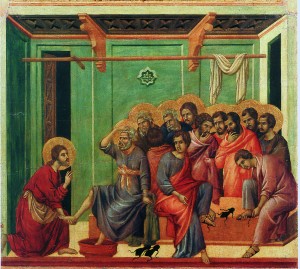
“The Footwashing,” by Duccio di Buoninsegna
Speaking of typical Catholics, what will the typical parish priest face now that he didn’t face before the Synod began? What pressures, such as the washing of women’s feet on Maundy Thursday after the example of Francis, will burden the parish priest even more than he is burdened today?
A typical Catholic parish priest should know well the perennial sense of the Catholic Faith, the perennial sense as well of the laws of the Catholic liturgy and, knowing this, he should have an interior sureness and firmness. He should always remember the Catholic principle of discernment: “Quod semper, quod ubique, quod ab omnibus,” i.e., “What has been always, everywhere and by all” believed and practiced.
The categories “always, everywhere, by all” are not to be understood in an arithmetical, but in a moral sense. A concrete criterion for discernment is this: “Does this change in a doctrinal affirmation, in a pastoral or in a liturgical practice, constitute a rupture with the centuries-old, or even with the millennial past? And does this innovation really make the Faith shine clearer and brighter? Does this liturgical innovation bring us closer to the sanctity of God, or manifest the divine mysteries more deeply and more beautifully? Does this disciplinary innovation really increase a greater zeal for holiness of life?”
Concretely, as to the innovation of washing the feet of women during the Holy Mass of the Last Supper on Holy Thursday: this Holy Mass celebrates the commemoration of the institution of the sacraments of the Eucharist and the priesthood. Therefore, the footwashing of women along with the men not only distracts from the main focus on Eucharist and on priesthood, but also generates confusion regarding the historical symbolism of the “twelve” and of the apostles being of the male sex. The universal tradition of the Church never allowed the footwashing during the Holy Mass, but instead outside of Mass, in a special ceremony.
By the way: the public washing and usually also kissing of the feet of women on the part of a man, in our case, of a priest or a bishop, is considered by every person of common sense in all cultures as being improper and even indecent. Thanks be to God, no priest or bishop is obliged to publicly wash the feet of women on Holy Thursday, for there is no binding norm for it, and the footwashing itself is only facultative.
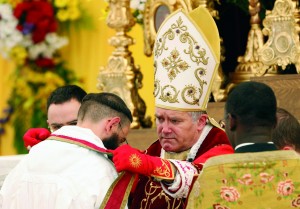
Bishop Bernard Fellay, superior of the Society of St. Pius X, ordains a priest during a ceremony in Econe, Switzerland, June 29. The Vatican has said it considers such ordinations “illegitimate,” although the priests are validly ordained. (CNS photo/Denis Balibouse, Reuters)
Priestly Society of St. Pius X (SSPX)
A non-typical situation in the church is the Priestly Society of St. Pius X (SSPX). Why does Your Excellency think that so many Catholics are afraid of the SSPX or anxious about any association with it? From what Your Excellency has seen, what gifts do you think the SSPX can bring to the mainstream Church?
When someone or something is unimportant and weak, nobody has fear of it. Those who have fear of the Priestly Society of St. Pius X ultimately have fear of the perennial Catholic truth and of its demands in the moral and the liturgical domain.
When the SSPX tries to believe, to worship and to live morally the way our forefathers and the best-known saints did during a millennial period, then one has to consider the life and the work of these Catholic priests and faithful of the SSPX as a gift for the Church in our days — even as one of the several instruments which Divine Providence uses to remedy the enormity of the current general crisis of the Faith, of morals and of the liturgy of the Church.
In some sectors of the SSPX there are, however, as is the case in every human society, some eccentric personalities. They have a method and a mindset which lack justice and charity and consequently the true sentire cum ecclesia [“feel with” or “think with” the Church] and there is the danger of an ecclesial autocephaly and of being the last judicial instance in the Church. However, to my knowledge, the healthier part corresponds to the major part of the SSPX and I consider their Superior General, His Excellency Bishop Bernard Fellay, as an exemplary and true Catholic bishop. There is some hope for a canonical recognition of the SSPX.
The Synod and Papolatry
Back to the Synod… while focusing on Tradition, does Your Excellency believe that the changes in the Roman liturgy post-Vatican II contributed to the current crisis in the Church, the crisis of marriage, the family and societal morality in general?
I wouldn’t affirm this in such a way. Indeed the very source of the current crisis in the Church, the crisis of marriage, of the family and of morality in general is not the liturgical reform, but defects in faith, the doctrinal relativism from which flow moral and liturgical relativism. For, if I believe in a defective manner, I will live a defective moral life and I will worship in a defective, indifferent manner. It is necessary first to restore the clearness and firmness of the doctrine of faith and morals on all levels and, from there, start to improve the liturgy. The integrity and the beauty of the faith demand the integrity and beauty of one’s moral life, and this demands the integrity and beauty of public worship.

U.S. Cardinal Raymond L. Burke, prefect of the Supreme Court of the Apostolic Signature (CNS photo/Paul Haring)
Still on the Synod, it is clear to those with eyes to see that Pope Francis caused confusion instead of clarity in the Synod process, and encouraged a turn toward rupture by elevating the role of Cardinals Kasper and Danneels, Archbishop Cupich, etc. What is the proper attitude a Catholic should have towards the Pope in these troubled times? Are Catholics obliged to make their views known and “resist” as Cardinal Burke said in an interview last year with us, even when their views are critical of the Pope?
For several past generations until our days, there reigns in the life of the Church a kind of “Pope-centrism” or a kind of “papolatria” which is undoubtedly excessive compared with the moderate and supernatural vision of the person of the Pope and his due veneration in past times. Such an excessive attitude towards the person of the Pope in practice generates an excessive and wrong theological meaning regarding the dogma of papal infallibility.
If the Pope would tell the entire Church to do something which would directly damage an unchangeable divine truth or a divine commandment, every Catholic would have the right to correct him in a duly respectful form, moved out of reverence and love for the sacred office and person of the Pope. The Church is not the private property of the Pope. The Pope can’t say, “I am the Church,” as did the French King Louis XIV, who said: “L’Etat c’est moi” (“I am the state”). The Pope is only the vicar, not the successor of Christ.
Concern about the purity of the Faith is ultimately a matter of all members of the Church, which is one, and a unique living body. In ancient times, before entrusting to someone the office of a priest and of a bishop, the faithful were asked if they could guarantee that the candidate had the right faith and a high moral conduct. The old Pontificale Romanum says:
“The captain of a ship and its passengers alike have reason to feel safe or else in danger on a voyage; therefore they ought to be of one mind in their common interests.”
It was the Second Vatican Council which very much encouraged the lay faithful to contribute to the authentic good of the Church, in strengthening the Faith.
I think in a time in which a great part of the holders of the office of the Magisterium are negligent in their sacred duty, the Holy Spirit calls today, namely the faithful, to step into the breach and defend courageously with an authentic sentire cum ecclesia the Catholic Faith.
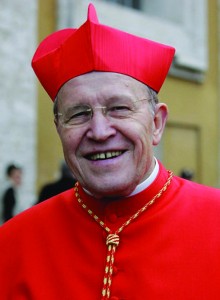
Cardinal Walter Kasper
Tradition and its Enemies from Within
Is the Pope the measure of Tradition, or is he measured by Tradition? And should faithful Catholics pray for a traditional Pope to arrive soon?
The Pope is surely not the measure of tradition, but on the contrary. We must always bear in mind the following dogmatic teaching of the First Vatican Council: The office of the successors of Peter does not consist in making known some new doctrine, but in guarding and faithfully expounding the Deposit of Faith transmitted by the Apostles (cf. Constitutio Dogmatica Pastor Aeternus, cap. 4).
In fulfilling one of his most important tasks, the Pope has to strive so that “the whole flock of Christ might be kept away from the poisonous food of error” (First Vatican Council, ibid.). The following expression which was in use since the first centuries of the Church, is one of the most striking definitions of the papal office, and has to be in some sense a second nature of every Pope: “Faithfully adhering to the tradition received from the beginning of the Christian Faith” (First Vatican Council, ibid.).
We must always pray that God provides His Church with tradition-minded Popes. However, we have to believe in these words: “It is not for you to have knowledge of the time and the order of events which the Father has kept in his control ” (Acts 1:7).
We know there are many bishops and cardinals — possibly the majority — who want to change the Church’s doctrinal language and long-standing discipline under the excuses of “development of doctrine” and “pastoral compassion.” What is wrong with their argument?
Expressions like “development of doctrine” and “pastoral compassion” are in fact usually a pretext to change the teaching of Christ, and against its perennial sense and integrity as the Apostles had transmitted it to the whole Church, and it was faithfully preserved through the Fathers of the Church, the dogmatic teachings of the Ecumenical Councils and of the Popes.
Ultimately, those clerics want another Church, and even another religion: A naturalistic religion, which is adapted to the spirit of the time. Such clerics are really wolves in sheep’s clothing, often flirting with the world. Not courageous shepherds — but rather cowardly rabbits.
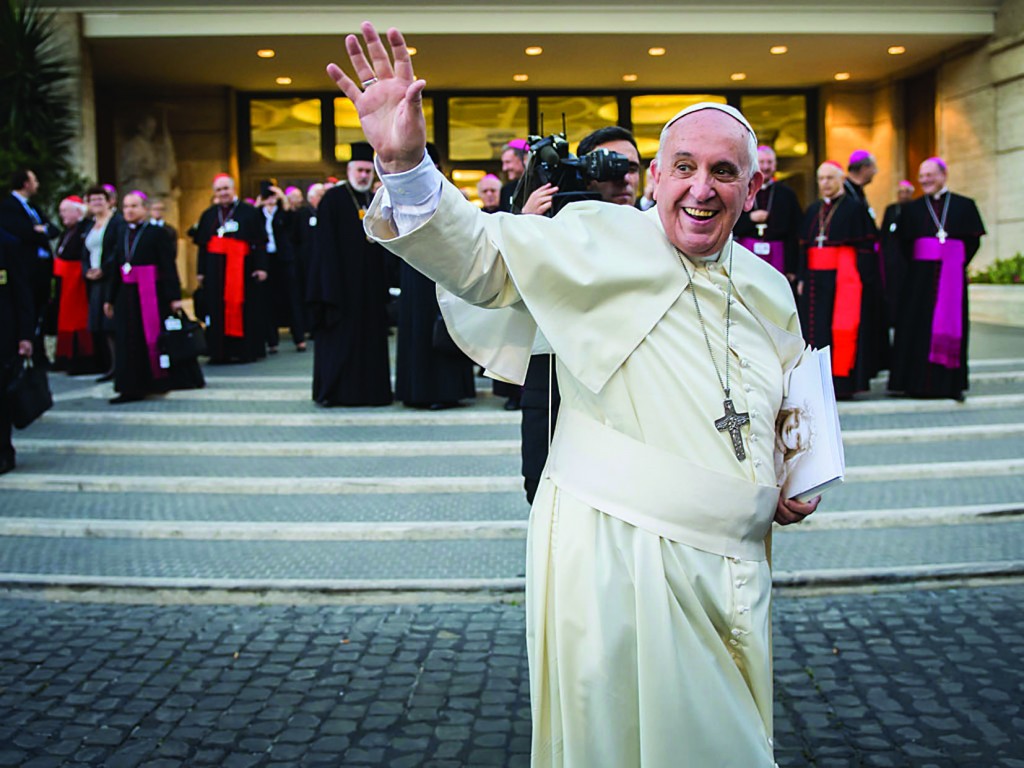
Pope Francis waving as he leaves a session of the Synod
Role of Women in the Church
We hear a lot today about the role of women in the Church — the so-called “feminine genius.” Women obviously have played a critical role in the Church since the beginning, starting with the Blessed Virgin Mary. But liturgically, Christ made His position crystal clear, as have pre-conciliar Popes. Does Your Excellency believe that female involvement in the liturgy, whether it’s women taking part in the Novus Ordo Mass or girl altar servers, has played a positive or negative role in the Church the last four decades?
There is no doubt about the fact that female involvement in the liturgical services at the altar (reading the lesson, serving at the altar, distributing Holy Communion) represents a radical rupture with the entire and universal tradition of the Church. Therefore, such a practice is against the Apostolic Tradition.
Such a practice gave to the liturgy of the Holy Mass a clear Protestant shape and a characteristic of an informal prayer meeting or of a catechetical event. This practice is surely contrary to the intentions of the Fathers of the Second Vatican Council, and there is not in the least an indication for it in the Constitution on the Sacred Liturgy.
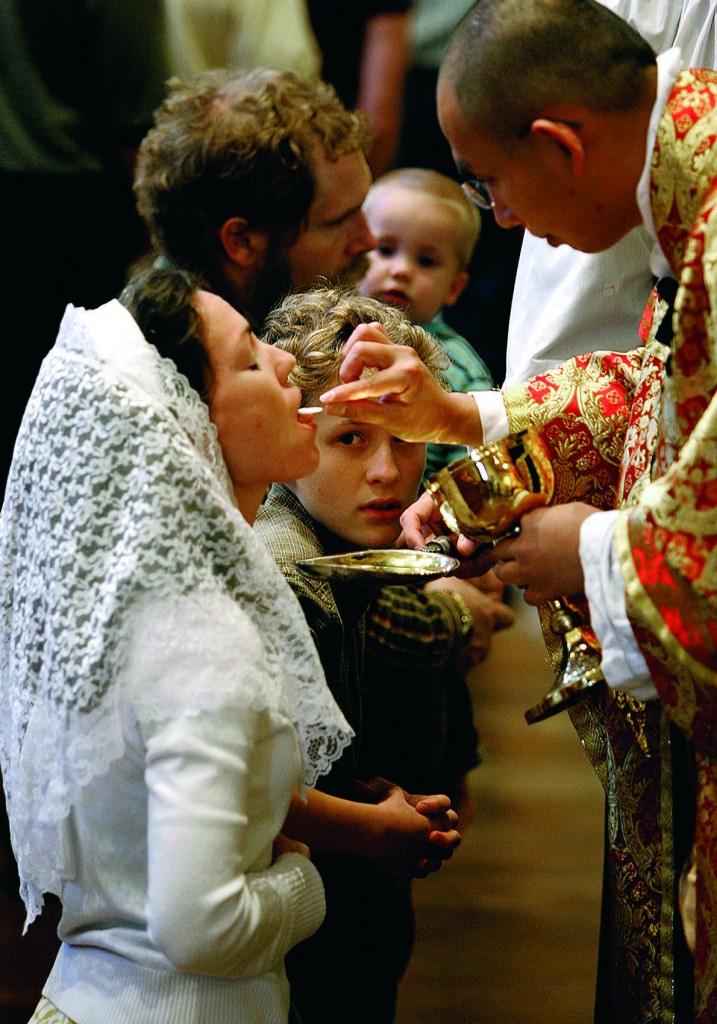
Father Edward Yew distributes Communion during a Tridentine Mass at St. Therese Church in Collinsville, Okla. (CNS photo/David Crenshaw, Eastern Oklahoma Catholic)
The Traditional Latin Mass
Your Excellency is well known for celebrating the traditional Latin Mass in many places around the world. What does Your Excellency find to be the deepest lessons learned from saying the Latin Mass, as a priest and as a bishop, that other priests and bishops may hope to gain by saying the traditional Mass themselves?
The deepest lesson I learned from celebrating the traditional form of the Mass is this: I am only a poor instrument of a supernatural and utmost sacred action, whose principal celebrant is Christ, the Eternal High Priest. I feel that during the celebration of the Mass I lost in some sense my individual freedom, for the words and the gestures are prescribed even in their smallest details, and I am not able to dispose of them. I feel most deeply in my heart that I am only a servant and a minister who yet with free will, with faith and love, fulfill not my will, but the will of Another.
The traditional and more than millennial-old rite of the Holy Mass, which not even the Council of Trent changed, because the Ordo Missae before and after that Council was almost identical, proclaims and powerfully evangelizes the Incarnation and the Epiphany of the ineffably saintly and immense God, who in the liturgy as “God with us,” as “Emmanuel,” becomes so little and so close to us. The traditional rite of the Mass is a highly artful and, at the same time, a powerful proclamation of the Gospel, realizing the work of our salvation.
If Pope Benedict is correct in saying that the Roman Rite currently (if strangely) exists in two forms rather than one, why has it not yet happened that all seminarians are required to study and learn the traditional Latin Mass as part of their seminary training? How can a parish priest of the Roman Church not know both forms of the one rite of his Church? And how can so many Catholics still be denied the traditional Mass and sacraments if it is an equal form?
According to the intention of Pope Benedict XVI and the clear norms of the Instruction Universae Ecclesiae, all Catholic seminarians have to know the traditional form of the Mass and be able to celebrate it. The same document says that this form of Mass is a treasure for the entire Church — thus it is for all of the faithful.
Pope John Paul II made an urgent appeal to all bishops to accommodate generously the wish of the faithful regarding the celebration of the traditional form of the Mass. When clerics and bishops obstruct or restrict the celebration of the traditional Mass, they don’t obey what the Holy Spirit says to the Church, and they are acting in a very anti-pastoral way. They behave as the possessors of the treasure of the liturgy, which does not belong to them, for they are only administrators.
In denying the celebration of the traditional Mass or in obstructing and discriminating against it, they behave like an unfaithful and capricious administrator who — contrary to the instructions of the house-father — keeps the pantry under lock and key, or like a wicked stepmother who gives the children meager fare. Perhaps such clerics have fear of the great power of the truth irradiating from the celebration of the traditional Mass. One can compare the traditional Mass with a lion: Let him free, and he will defend himself.
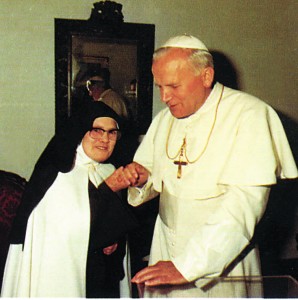
Pope John Paul II with Sister Lucia, one of the three children at Fatima. She received a message from Our Lady asking that Russia be consecrated to her Immaculate Heart
Russia not yet Explicitly Consecrated
There are many Russian Orthodox where Your Excellency lives. Has Alexander of Astana or anyone else in the Moscow Patriarchate asked Your Excellency about the recent Synod or about what is happening to the Church under Francis? Do they even care at this point?
Those Orthodox prelates with whom I have contact generally are not well informed about the current internal disputes in the Catholic Church, or at least they have never spoken with me about such issues. Even though they don’t recognize the jurisdictional primacy of the Pope, they nevertheless look on the Pope as the first hierarchical office in the Church, from a point of view of the order of protocol.
We are just a year away from the 100th anniversary of Fatima. Russia was arguably not consecrated to the Immaculate Heart of Mary and certainly not converted. The Church, while ever spotless, is in complete disarray — maybe worse than during the Arian heresy. Will things get even worse before they get better, and how should truly faithful Catholics prepare for what is coming?
We have to believe firmly: The Church is neither ours nor the Pope’s. The Church is Christ’s, and He alone holds and leads her indefectibly even through the darkest periods of crisis, as our current situation indeed is.
This is a demonstration of the divine character of the Church. The Church is essentially a mystery, a supernatural mystery, and we cannot approach her as we approach a political party or a purely human society. At the same time, the Church is human and on her human level she is nowadays enduring a sorrowful passion, participating in the Passion of Christ.
One can think that the Church in our days is being flagellated as was Our Lord, is being denuded as was Our Lord at the Tenth Station of the Cross. The Church, our Mother, is being bound in cords not only by the enemies of Christ but also by some of their collaborators in the ranks of the clergy, even sometimes of the high clergy.
All good children of Mother Church, as courageous soldiers, have to try to free this mother — with the spiritual weapons of defending and proclaiming the truth, promoting the traditional liturgy, Eucharistic adoration, the crusade of the Holy Rosary, the battle against sin in one’s private life and striving for holiness.
We have to pray that the Pope may soon explicitly consecrate Russia to the Immaculate Heart of Mary. Then she will win, as the Church prayed since the old times: “Rejoice O Virgin Mary, for thou alone hast destroyed all heresies in the whole world ” (“Gaude, Maria Virgo, cunctas haereses sola interemisti in universo mundo”).
Liturgy Opinion: A Sixth Instruction on the Reform of the Liturgy?
A teacher at Sant’Anselmo in Rome, which focuses on Church liturgy, has a view on the liturgy which is virtually the opposite of Bishop Schneider’s view. In a recent article, Prof. Andrea Grillo argues that Pope Francis should change the direction of the past 15 years of the liturgical reform — called during the pontificate of Pope Benedict XVI “the reform of the reform” — and issue a sixth Instruction on the Liturgy, one more “progressive” than the 2001 document Liturgiam Authenticam, which sought to restrict liturgical experimentation and aberrations. Here are excerpts from his text. —The Editor
Professor Grillo begins by writing: “In the structure of Pope Francis’ pontificate — it cannot be said frequently enough — the liturgy has a place, not of ‘direct discourse,’ but rather of ‘indirect practice.’ This is because the Pope is a ‘son of the Council,’ which he incarnates in supple and concrete ways. In his Masses at Casa Santa Marta, his Wednesday audiences, and his Sunday homilies, as well as in his major discourses and specifically liturgical measures (for example, the modification of the rubrics of the Holy Thursday footwashing), it is clear that Francis celebrates the liturgy with ‘the joy of the Gospel.’”
Grillo continues: “But there is more. Francis’ ‘programmatic’ text, Evangelii Gaudium, lays out an ecclesial vision of a church on mission — like a ‘field hospital’ — in a way that draws new attention to the relationship between liturgy and life, and between liturgy and culture. This vision is expressed in Francis’ intention to decentralize curial power, entrusting to regional episcopacies competence that is even doctrinal in character.”
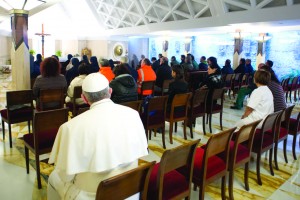
Pope Francis sits with Vatican workers after celebrating Mass March 22 inside the chapel of the Domus Sanctae Marthae, the Vatican residence where the new pontiff resides (CNS photo/L’Ossevatore Romano)
He continues: “The appropriation of such decentralization within the teaching of Evangelii Gaudium itself is already highly significant. All of this contrasts fundamentally with what has been happening in the area of liturgy for the past 15 years, since the promulgation of the fifth Instruction “For the Right Implementation of the Constitution on the Sacred Liturgy,” Liturgiam Authenticam (2001). That document has effectively stalled at the universal level every effort at authentic inculturation of the liturgy.”
He continues: “Liturgiam Authenticam called for a universal retooling of the liturgy based on its Latin prototype — one that is inevitably static and closed off — by favoring an obstinately and scholastically literal translation and by pretending that the vernacular languages bear the same structure and rhetorical elements as Latin. This has been, from the beginning, a project lacking any solid foundation, not only in simple, human experience, but also in the tradition of the Church.”
After taking a slap at the use of Latin in the liturgy (“Who could have devised such an abstruse and self-referential system? If the entire structure is determined by a language that ‘has no future’ — which is the case for Latin, a language without the capacity for renewal, a quality that some find reassuring, because that means it is also deprived of a history — how long will it be before tradition is reduced to nothing more than a ‘wax museum’?”), Grillo makes his proposal: “After a troubled 15-year reign, Liturgiam Authenticam has reached the end of its line. Not only have legitimate criticisms been raised from the start, from both doctrinal and pastoral points of view, but the facts have demonstrated it to be, throughout these years, both flawed in theory and virtually inapplicable in practice… The literalistic radicalism of Liturgiam Authenticam has generated division and despair, and this was easily predictable 15 years ago. It is clear now that the most widespread sentiment among the leadership of episcopal conferences throughout the world is fear… There can be no authentic liturgy until we reject the lifeless and defensive stance of Liturgiam Authenticam, which will only give us a Church that is closed and locked in its own past, where the liturgy becomes a ‘diocesan museum,’ with air conditioning and bulletproof glass cases. This is now the conditio sine qua non: either a new, sixth instruction on liturgical reform is written, or we will be increasingly dominated by fear, paralysis, and immobility.”
—Reprinted from praytellblog.com, where it was printed with the permission of Munera. Rivista Europea di Cultura. Andrea Grillo teaches liturgy at Sant’Anselmo in Rome. He is the author of Beyond Pius V: Conflicting Interpretations of the Liturgical Reform, published by Liturgical Press.

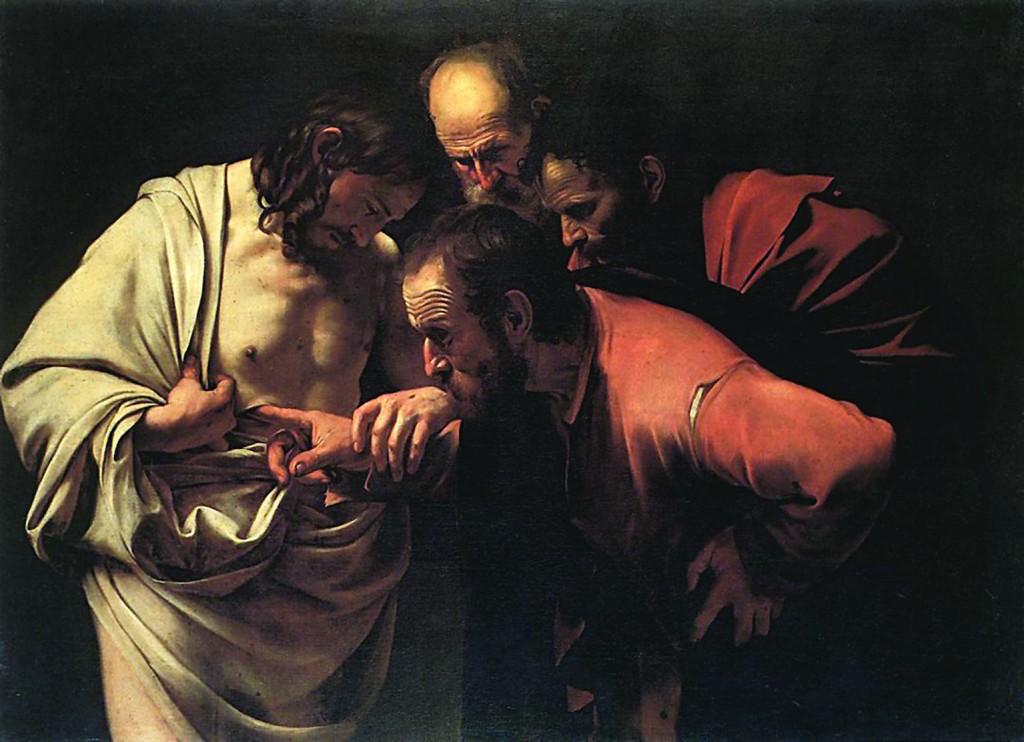
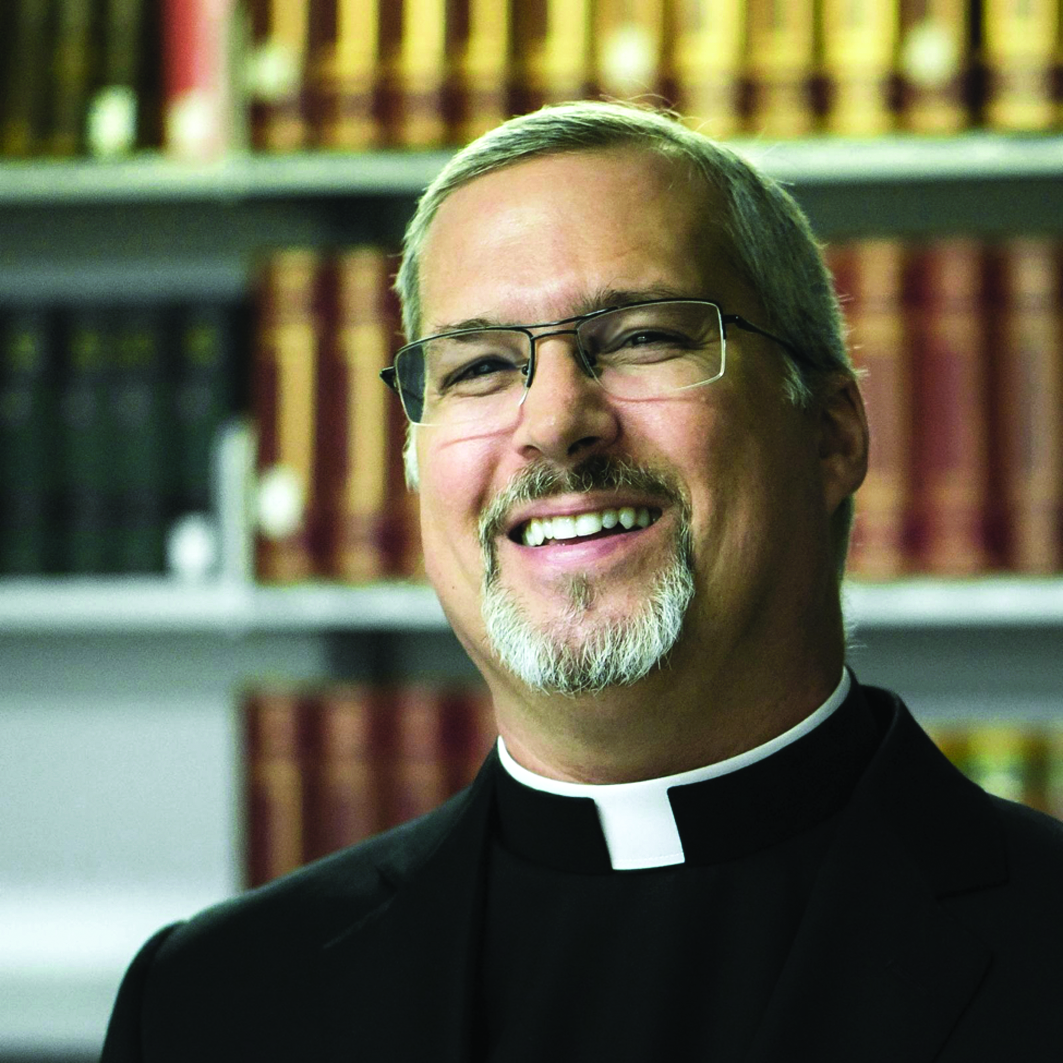
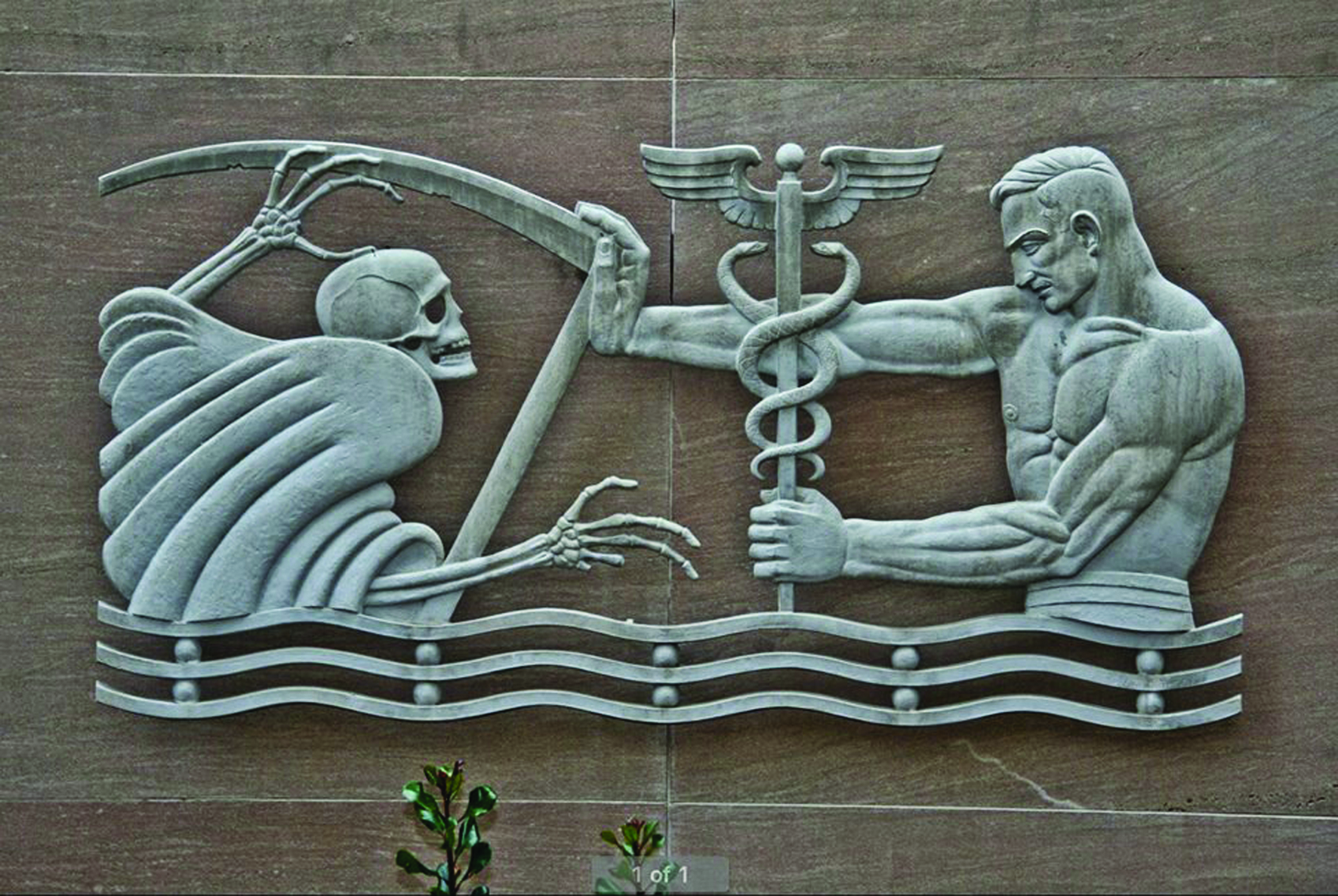



Facebook Comments